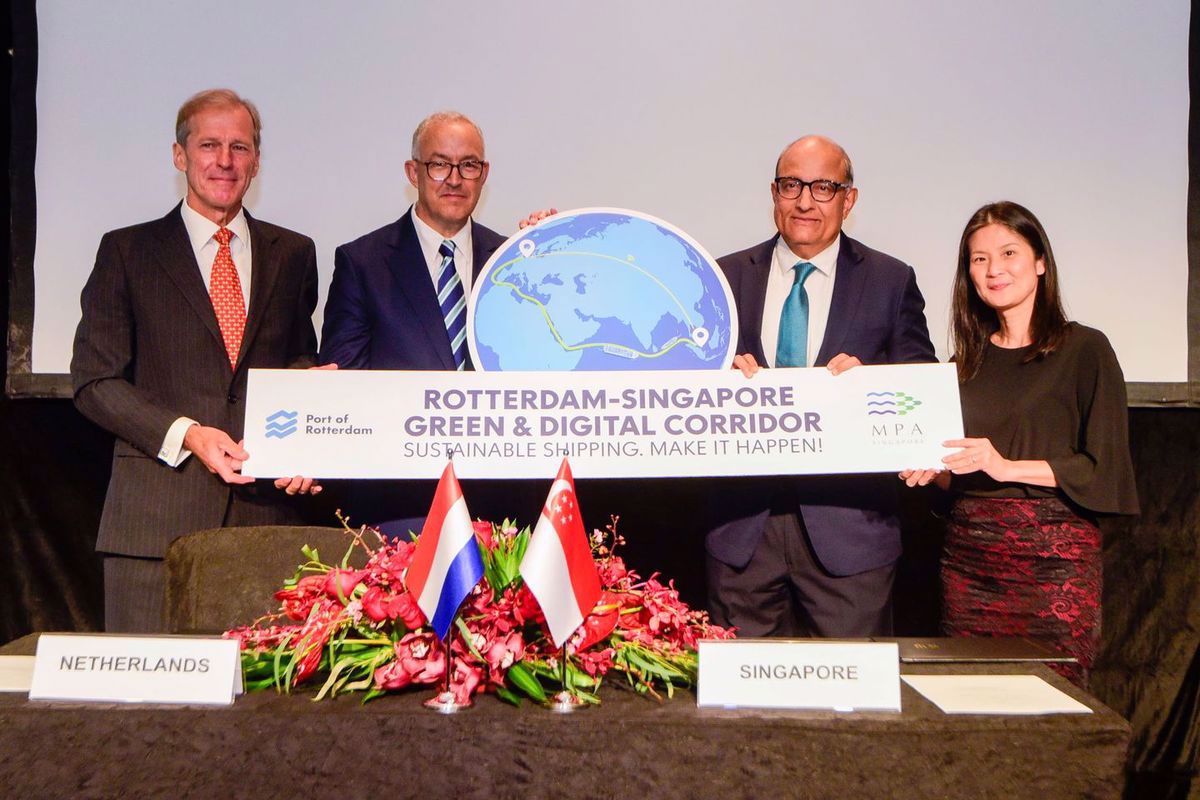Green shipping corridors can drive the energy transition - ABS
Shipping classification society American Bureau of Shipping (ABS) is backing green corridors to decarbonise shipping as these corridors are gaining momentum in the industry.

PHOTO: The Rotterdam-Singapore green corridor was announced last month by Port of Rotterdam Authority chief executive Allard Castelein, Mayor of Rotterdam Ahmed Aboutaleb, Singapore's Minister of Transportation and Trade Relations S. Iswaran, and Maritime and Port Authority of Singapore chief executive Quah Ley Hoon. Port of Rotterdam
Green corridors will tie into national clean energy transition strategies that will highlight shipping as a “value enabler” for the clean energy transition said ABS chairman, president, and chief executive Christopher Wiernicki said at the recent Global Clean Energy Action Forum. During the meeting of 31 countries, he said only green shipping corridors will be effective at addressing the complex challenge of decarbonisation.
Nevertheless, he cautioned that reliable data sharing to establish trust between many partners is a critical success factor for every corridor.
Kickstarting the transition
A green corridor is a relatively recent concept in shipping. It started gaining momentum after the COP26 climate summit last November. 22 countries signed up to establish six zero-emission shipping corridors by 2025.
Researchers at the UCL Energy Institute have called green corridors “critical” enablers of near-term adoption of zero-emission fuel and vessel technologies. The idea is that these corridors can help allow shipping firms and fuel suppliers to attain operational experience with alternative fuels, establish standards for safe handling and consumption, create demand and incentivise production and supply of these fuels, and eventually drive down costs.
The researchers found that green corridors can put shipping on track to consume at least 5% zero-emission fuels by 2030. If that target is reached, and with possibilities for greater scale, it would give shipping a chance at full decarbonisation by 2050, they have argued.
A flurry of green corridor announcements have been made this year. Most recently, a group of Finnish companies and researchers said they will set up a corridor between Turku in Finland and Stockholm in Sweden by 2027. The route is operated by Viking Line ferries. The project received $1.6 million in funding from the Finnish government's business development organisation, Business Finland.
In an interview with Engine this month, Sweden’s Port of Gothenburg confirmed that it is working to establish a green shipping corridor, without disclosing exactly where it will run to.
This followed a major announcement from the port authorities of Singapore and Rotterdam to set up what could become the world’s longest green corridor for low- and zero-carbon shipping.
Earlier this year, Nordic climate and environment ministers agreed to work together to establish green corridors for emission-free shipping between ports in the Nordic region.
In another project, the Port of Long Beach joined the Shanghai-Los Angeles Green Shipping Corridor with the aim of decarbonising shipping on this major trans-Pacific trade route by 2030.
In March, the Mærsk Mc-Kinney Møller Center for Zero Carbon Shipping announced a green corridors network spanning Hamburg, Gdynia, Ronne, Rotterdam and Tallinn.
It followed up with another green corridor announcement in April, after it had struck a deal with Chile’s Ministry of Energy. Chile has been brought forward as a country with great potential for zero-carbon fuels production.
By Konica Bhatt
Please get in touch with comments or additional info to news@engine.online





